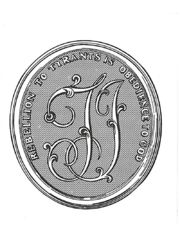“All the strength and beauty of the antithesis”
Yesterday I quoted “Bradshaw’s Epitaph” as first printed in December 1775. No American politician liked its final line—“Rebellion to tyrants is obedience to God”—more than Thomas Jefferson.
In late 1776, that statement was one of two possible mottoes that Jefferson proposed for the independent state of Virginia. As governor of Virginia in 1780, he had it engraved on a medal to be shared with Native American allies.
(The other possible motto was “Rex est qui regem non habet,” words from a Latin satire by the Dutch scholar and statesman Janus Dousa. I think for Jefferson that translated into “Whoever doesn’t have a king over him is a king.”)
Jefferson also had the “Rebellion to tyrants” line engraved on one of his personal seals, shown here, courtesy of Monticello. He was using this seal on his letters by 1790.
In an 1823 letter discussing the value of bending grammatical rules for the sake of style, Jefferson wrote:
TOMORROW: What did Jefferson really think of “Bradshaw’s Epitaph”?
In late 1776, that statement was one of two possible mottoes that Jefferson proposed for the independent state of Virginia. As governor of Virginia in 1780, he had it engraved on a medal to be shared with Native American allies.
(The other possible motto was “Rex est qui regem non habet,” words from a Latin satire by the Dutch scholar and statesman Janus Dousa. I think for Jefferson that translated into “Whoever doesn’t have a king over him is a king.”)
Jefferson also had the “Rebellion to tyrants” line engraved on one of his personal seals, shown here, courtesy of Monticello. He was using this seal on his letters by 1790.
In an 1823 letter discussing the value of bending grammatical rules for the sake of style, Jefferson wrote:
to explain my meaning by an English example, I will quote the motto of one, I believe, of the regicides of Charles I. ‘Rebellion to tyrants is obedience to God.’ correct it’s syntax ‘Rebellion against tyrants is obedience to God,’ it has lost all the strength and beauty of the antithesis.Jefferson famously died on 4 July 1826. Two years later, Nicholas Philip Trist, a grandson-in-law, went through his papers at Monticello researching a legal question. Trist later wrote a memo about what he had found, quoted by Henry S. Randall in his 1858 Life of Thomas Jefferson. Here’s the relevant bit:
It occurred to me to ascertain what might be the contents of a little trunk, evidently very old, which, on visiting a closet over the alcove containing his bed, I had noticed among the many old things collected there. Ascending once more the steep step-ladder which led to this omnium gatherum, I raised the lid of that little trunk, upon which lay a thickness of dust, indicating that it had not turned upon its hinges for a long period. It was filled with papers—law papers almost exclusively. . . .The page also included a note at the bottom, “evidently a remark by Mr. J. himself,” Trist wrote:
The bundles were, of course, all examined by me—the tape around them giving way in the act of untying it. In one I found the epitaph of John Bradshaw; and, in its company, copies of several letters bearing date years before the earliest of those contained among his papers as arranged by himself, which, to the best of my recollection, began in 1779. Among them was one to his old preceptor Dr. [William] Small, two to John Randolph, and one to Dr. Franklin; the three former written in 1775, the last in 1777. . . . These MSS. were in Mr. Jefferson's hand-writing of that period; the most beautiful, to my taste, I have ever seen.
From many circumstances, there is reason to believe there does not exist any such inscription as the above, and that it was written by Dr. Franklin, in whose hands it was first seen.Wait. So the whole epitaph was a hoax by Benjamin Franklin?
TOMORROW: What did Jefferson really think of “Bradshaw’s Epitaph”?


No comments:
Post a Comment